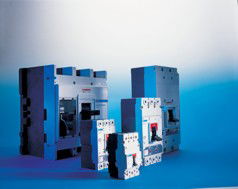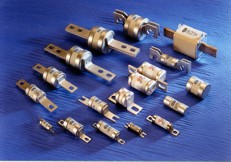Thermal and electromagnetic low-voltage (LV) circuit protection devices are critical for the safety of people and equipment. James Hunt introduces this VoltiBULLETIN on fuses v circuit-breakers by taking a look at these devices:

Reliable circuit protection devices are required wherever electrical current flows. Such devices are fuses, miniature circuit breakers (MCBs), and moulded case circuit breakers (MCCBs). They help protect cables and other electrical equipment, as well as cutting the danger of fire occurring through electrical fault.
The old argument of fuses versus fuseless technologies is not of value - the one is not intrinsically better than the other. Each technology has pros and cons.
Fuses:
Everyone knows something about the fuse - many people still have re-wirable fuses in their homes. Even so, it may still surprise many to know that the first recorded use of a fuse to protect electrical equipment was way back in 1864. However, there is more to modern fuses than meets the eye and this method of circuit protection is ideal for many modern requirements. Today's fuses present lots of benefits for installers, as well as end-users.
The highly reliable fuse is a simple but very effective one-shot thermal device which provides a primary means of protecting electrical circuits against over-current and short-circuits. This is achieved through the extremely rapid melting of internal element(s) through which the fault current flows. The fuse is rated so that current flow is interrupted when it reaches a predictable magnitude for a fixed time period. Fuses limit overloads to a single circuit and minimise the danger of fire in the equipment and the circuit leading to it. Fuses are also relatively low-cost items and are highly compact. The space saving alone can save a lot of money.
For some applications, fuses still provide the best method of protection. Very compact fuses limit overloads to a single circuit and minimise fire danger. Cartridge fuses limit the short circuit fault current and energy let-through; current limitation is a strong benefit. High breaking capacity and good power quality are other advantages. Fuses are, therefore, also ideal for protecting equipment such as variable speed drives.
Fuses (with their switchfuses) are cheaper than circuit breakers, at least up to around 400A. They are also interchangeable with those from other manufacturers, so minimising the cost of stocking spares. Discrimination and selectivity is easy to achieve - simply fit the right element. However, fuses - unlike electromagnetic devices - cannot be precisely matched to current requirements, so specification of oversized cables to match the fuse's current rating may be necessary. This can waste money.
Current limiting high-speed fuses provide short circuit / overload protection for many types of power semiconductors.
Motor circuit protection by fuses:
Fuses allow well coordinated protection with other circuit equipment. A good example is motor circuit protection. In this application, the fuse is chosen to withstand the motor starting current, so may need a higher rating than the motor’s full load current. The overload unit provides low overcurrent protection and the fuse provides short circuit protection. Fuse manufacturers can provide information about suitable gG or gM fuses.
Motor starter manufacturer's coordination recommendations are made in accordance with IEC 60947-4-1 to give the required Type 2 co-ordination using fuses, but verification tests will be needed.
In motor circuit protection applications, the fuse's excellent current limiting characteristics prevents contactor (and overload relay) thermal damage, and also avoids mechanical damage (the peak let-through current is low). Without the fuse, the fault current electromagnetic forces could cause contact welding.
Circuit breakers:
Electromagnetic circuit breakers automatically disconnect on over-current. Magnetic breakers are resilient to small overloads and current surges but react very quickly to fault conditions. Although circuit breakers cost more than fuses, and take up more space, they have their own advantages: they are re-settable, and are often much easier to troubleshoot. Their disadvantage is that they cannot match the fuse's high energy limitation.
MCBs - These generally contain two automatic disconnect devices, and a bimetallic strip which curls in response to current flowing. If the current is large enough, disconnection occurs. This thermal device will detect small overloads, but the response is quite slow, so that overloads of (say 150%) - which last only a brief period - will not disconnect. Longer-term overloads will disconnect. Typical short-circuit breaking capacities are 6 -10kA - above this, it is usual to use MCCBs. Choosing MCBs for final circuit protection is simple, but understanding their ability to handle surge currents without tripping is essential.
MCCBs - These have both time-delayed and instantaneous tripping functions, and must be sized to prevent the instantaneous element from tripping on starting current. Standard MCCBs can take up to two full cycles to interrupt current, making current-limiting devices better for high-fault-current applications. Some MCCBs can interrupt high currents within the first quarter cycle, so greatly limiting adverse thermal and mechanical effects on electrical equipment, but they are more expensive.
RCDs - The residual current device (RCD) detects current flowing to earth and ensures that an electric shock is not a fatal experience. All sockets which have outdoor electrical equipment plugged into them should be RCD protected. Earth currents are low, so RCDs are very sensitive - typically 30mA - and must trip within 0.04s (the time-delayed type takes longer). This sensitivity allows detection of other faults such as partial live/earth breakdown, which may cause a fire. RCDs cannot protect against live-neutral shock or overloads, so they are used with MCBs / fuses. A combined RCD/MCB results in an RCBO, performing earth leakage / over current protection functions in a single, compact unit.
The modern equivalent of the 'fuse box', the consumer unit, rarely today contains fuses - instead, MCBs and RCDs are generally fitted. Where a whole building is RCD protected, any trip will cause all the lights to fail - a potentially dangerous situation. To avoid this, the split load consumer unit features a main isolating switch feeding the lighting circuit protective devices directly; with the rest fed via an RCD.
Another type of circuit breaker is the air circuit breaker (ACB), but this is outside the scope of this article.
Some fusegear and circuit breaker examples:
Eaton's 20 to 125A rated Exel 2 switch-disconnectors and switch-disconnector-fuses make installation easier through generous wiring space. Exel 2 features strong sheet steel enclosures, box clamp earthing terminals for easier, faster earth termination, generous wiring space, and a quick make / break switching mechanism.
ABB offers a comprehensive range of switchfuses, fuses, MCBs, MCCBs and RCDs. System proM S280 MCBs provide over-current protection to 100A within a 17.5 mm single-pole module. These 80 / 100A 6kA Type B or C single- to four-pole devices allow compact distribution boards without needing a separate panel board.
Eaton's Memshield 2 15kA MCBs are ideal for use in high-rise commercial buildings where there are often high prospective fault current levels at the final distribution board. They provide a compact alternative to MCCBs and achieve short-circuit discrimination with downstream devices. The device can be converted to an RCBO by fitting an RCD 'pod'. The company's Series G 16A - 2,500A MCCBs are very compact, feature many front-fitted accessories, and are assembled, tested and despatched within hours of order receipt.
Schneider Electric's Merlin Gerin 1 to 125A current rated MCBs are ideal for distribution boards and loose enclosures. The compact single- or three-phase15kA C60 is available up to 63A, (B, C or D curves), and accepts cables to 35mm2. The 125A NG125 MCB has breaking capacities of 25, 36 and 50kA, and is suitable as an outgoer to final circuits fed from panels.
For more information on fuses and circuit-breakers, as well as discrimination and other issues, click on the other articles in this VoltiBULLETIN. Also, go to 'Circuit Breakers' in www.voltimum.co.uk under 'Technical Expertise', then 'Hot Topics'.
CONTACTS:
Contact: Janet Roadway
ABB Ltd.,
Grovelands House, Longford Road,
Exhall, Coventry CV7 9ND
Tel: 01628 487222
Fax: 01628 487223
Email: [email protected]
Web: www.abb.com
Eaton Electric Ltd.,
Reddings Lane, Birmingham B11 3EZ
Tel: 0121 685 2100
Fax: 0121 706 2012
Web: www.memonline.com
And: www.eaton.com
Schneider Electric UK
Braywick House East, Windsor Road,
Maidenhead, Berkshire SL6 1DN
Tel: +44 (0) 870 608 8 608
Fax: +44 (0) 870 608 8 606
Web: www.schneider.co.uk

